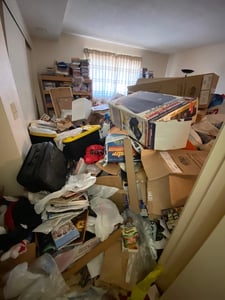
According to the American Psychiatric Association, hoarding is a disorder in which someone has extreme difficulty discarding items that others may sometimes view as valueless. This disorder leads to extreme clutter and disrupts their ability to function in their living and workspace. Hoarding is not simply being messy or collecting something. Hoarding is an extreme accumulation of a variety of materials.
Hoarding doesn’t only affect those who are afflicted, however. Hoarding can have an enormous effect on homes, family members, and entire communities and neighborhoods. While one person has the disorder, the consequences of hoarding are far-reaching.
In this article, we will explore how hoarding and its physical effects can have long-term consequences for both the hoarder’s property, as well as the property of their neighbors.
The Impact of Hoarding on the Property
The living conditions in a hoarder’s home can deteriorate quickly and become hazardous for anyone who lives there or who lives nearby. The typical hoarder can accumulate items such as newspapers, mail, books, clothing, boxes, and plastic bags. Garbage or rotten food are also commonly hoarded.
Because of this, a hoarder’s home poses specific health and safety hazards to all residents and neighbors including:
- Mold growth
- Pest infestations
- Structural damage
- Fire hazards
- Tripping hazards
- Respiratory diseases and infections
Besides health and safety, hoarding often affects the physical property of the hoarder as well. For example, hoarders often do not make efforts to keep their property in good repair. The amount of stuff in a hoarded home restricts technicians from performing maintenance on HVAC, electrical systems, and plumbing. Problems with these systems can result in flooding, sewage backup, and other damaging consequences.
The structural integrity of the home can also be compromised by rodent infestations as they make holes in walls, break ductworks, chew wiring, and damage the internal structures of the home. Mold grows quickly, and in large amounts, and can not only endanger people’s health but can also damage structural materials.
In short, the effects of hoarding can damage the structural integrity of a home quickly and permanently, lowering property values well below where they should be.
The Impact of Hoarding on a Community
We don’t like to tell someone how to live their lives, nor do we really have the right to in a lot of circumstances. While “minding your own business”
is often a good rule of thumb, when it comes to having a hoarder in the neighborhood, it often becomes your business, too.
The problems within the home can quickly spread outside the home, causing problems for the neighborhood. This can include issues due to flooding, backed-up sewage, pest infestations, and unsanitary conditions. There is also the potential for the property to become an eyesore as clutter moves from within the home to outside the home due to limited space.
All of these things can cause not just a headache, but damage to neighbors’ homes and property. Pests can infest other homes, flooding can damage other yards and structures, and backed-up sewage can be a problem for the entire neighborhood. In the end, all of these things can cost the neighbors a lot of money, while driving down property values for the entire neighborhood.
What to do When There’s a Hoarder in Your Neighborhood
 Unfortunately, many states lack laws against hoarding, making it hard for neighbors or other community victims to take action and get the courts involved. While animal hoarding falls under the category of cruelty and neglect and having minor children in the home can get social services involved, there are only a few ways neighbors can get involved if they have a hoarder in the neighborhood.
Unfortunately, many states lack laws against hoarding, making it hard for neighbors or other community victims to take action and get the courts involved. While animal hoarding falls under the category of cruelty and neglect and having minor children in the home can get social services involved, there are only a few ways neighbors can get involved if they have a hoarder in the neighborhood.
Building a relationship with the person whose hoarding is affecting your neighborhood is one way to help with the problem. Trying to understand what is going on with them, showing empathy, and recommending health services can help a great deal. Offering assistance in removing junk and getting things cleaned up is another way to be “neighborly” and help fix the issue.
If you are part of an HOA or COA, you can also go to the board to help resolve the issues at hand. Most HOAs and COAs have rules and regulations when it comes to hoarding for the good of all property owners.
If you find yourself in a neighborhood that is experiencing this problem, the professionals at Griswold Law can help guide you through the ins and outs of how to legally resolve the issue. Specializing in the health and safety receivership remedy, Griswold Law knows the ins and outs of working with local code enforcement teams to deal with a hoarding problem in a neighborhood for the sake of everyone’s health and safety. Contact one of our professionals today to discuss your concerns.



